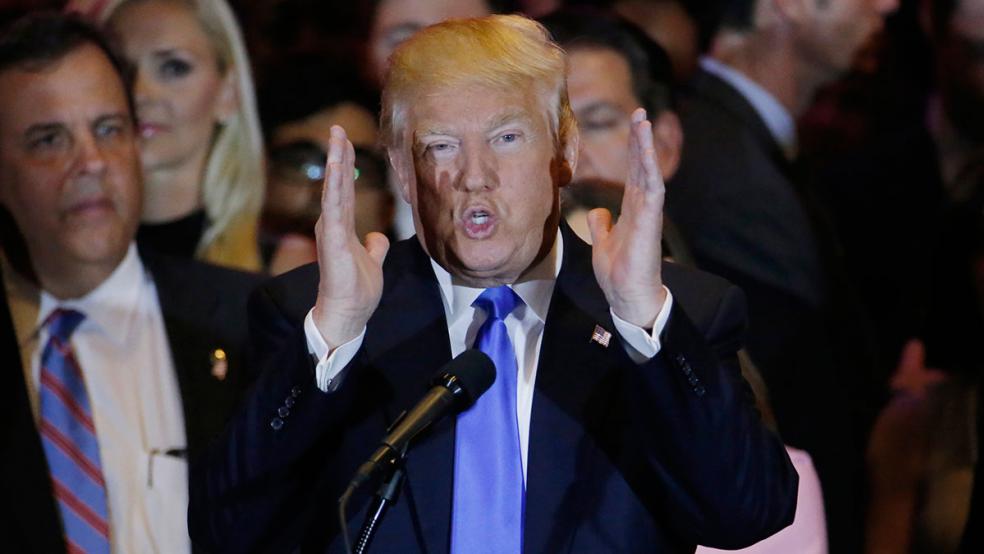Now that he is the Republican Party’s presumptive nominee for the presidency, there is no longer any justification for dismissing Donald Trump’s candidacy and his policy proposals as unserious or lacking in detail. He will be one of two major party candidates on the ballot in November, with a non-trivial chance of becoming the next president of the United States.
So, when Trump starts talking about things like overhauling the tax code, it’s now actually important to try to understand what he has in mind.
Related: Trump Retreats on Comments on Raising Taxes on the Wealthy
The trouble is that analyzing any plan put forward by the Trump campaign guarantees frustration because of something that we’ll call the “Trump uncertainty principle.” It holds that the more closely one observes an element of Donald Trump’s position on a given topic, the more likely the candidate is to change it.
Trump is now saying that his ideas on major tax reform are a work in progress, and that he will have to haggle with the Democrats and Republicans on Capitol Hill over the details of a plan if he wins the White House in November. Trump's chief policy advisor Sam Clovis did little to assure supporters of his candidate's commitment to his policy statements when he was asked about the billionaire's shifting positions on tax policy. “What this really does is allow us to signal to people on both sides of the aisle we’re not going to come in there fall on our swords over this. This is not going to be the hill we’re going to die on.”
Trump did, however, put a plan in writing in December that deserves close scrutiny. It would compress the seven current income tax brackets into three: 10 percent, 20 percent, and 25 percent. It would increase the standard deduction to $25,000 per person and $50,000 for joint filers, indexed to inflation.
Taxes on dividends and capital gains would be capped at 20 percent, but the plan would limit itemized deductions, with an exception for charitable giving and mortgage interest. It would increase the rate of the personal exemption phase-out and the limit on itemized deductions. It would repeal the Alternative Minimum Tax, The Estate Tax, and the Gift Tax.
Related: Trump Replaces His Untenable Debt Fix with a Different One
The corporate tax rate would be cut to 15 percent, which would also be the top pass-through rate for businesses. Trump would eliminate the carried interest loophole, as well as the corporate AMT. He would place a 10 percent tax on repatriated profits of the subsidiaries of U.S. firms payable over 10 years, and would collect taxes on such overseas profits as they are earned in the future.
An analysis of the plan by the Urban-Brookings Tax Policy Center found that the Trump plan was disproportionately beneficial to the wealthy, and would greatly increase the national debt.
“His proposal would cut taxes at all income levels, although the largest benefits, in dollar and percentage terms, would go to the highest-income households,” the TPC analysis found. “The plan would reduce federal revenues by $9.5 trillion over its first decade before accounting for added interest costs or considering macroeconomic feedback effects. The plan would improve incentives to work, save, and invest. However, unless it is accompanied by very large spending cuts, it could increase the national debt by nearly 80 percent of gross domestic product by 2036, offsetting some or all of the incentive effects of the tax cuts.”
Related: Trump Would Risk the ‘Full Faith and Credit’ of the US
The Fiscal Times asked a panel of distinguished experts in tax and fiscal policy to review the Trump proposal. They were uniformly unimpressed.
“This is pie-in-the-sky nonsense,” said William G. Gale, the Arjay and Frances Miller Chair in Federal Economic Policy at the Brookings institution and the co-director of the Tax Policy Center. Gale also served on the Council of Economic Advisers under President George H. W. Bush.
| Gale | Hoagland | Holtz-Eakin | Category average | |
| Legislative feasibility | D | C | F | D |
| Economic growth | D | C | C | C- |
| Fiscal responsibility | D | D | F | D- |
| Impact on taxpayers | F | C | C | D+ |
| Expert average | D- | C- | D- |
“It would lose an enormous amount of revenue, cut taxes dramatically for the very richest households,” he said. “It would dramatically increase deficits. I don't see how even a Republican-controlled legislature would have the guts to pass this.”
Bipartisan Policy Center senior vice president G. William Hoagland expressed “concern that such a tax plan if enacted would further increase tension and unrest over income distribution issues while not specifically addressing lower income poverty issue.”
Related: As Trump Turns to the General Election, He Flip Flops on Policy
Hoagland, who spent more than three decades working in the Senate, including a stint as director of budget and appropriations in the office of then-Senate Majority Leader Bill Frist (R-TN), said implementation of the Trump plan “might result in growing social and economic unrest increasing dangerous economic polarization.”
Douglas Holtz-Eakin, president of the American Action Forum, a conservative think tank, and former director of the Congressional Budget Office, said that from a legislative perspective, “The plan loses too much revenue to even be considered and lacks the cohesion of a genuine tax reform.” In terms of its impact on taxpayers, he said, “It reduces taxes for everyone, but at the expense of future taxpayers.”
Of course, analyzing the Trump tax policy is, as with all of his policy positions, complicated by how frequently he changes them.
In recent interviews with ABC’s George Stephanopoulos and NBC’s Chuck Todd, Trump appeared to suggest that he actually expects tax rates on the wealthy to go up under his plan.
"They're going down. But by the time it's negotiated, they'll go up," Trump said on ABC.
Related: Trump Fallout Is Alienating More Conservatives from The GOP
A day later, Trump was back on the air saying that what he had meant was that the rich would end up paying more than under his original proposal, but that they would still see their taxes lowered from where they stand today.
Regardless of where the bulk of the cuts are focused, all three experts noted that the Trump plan utterly fails to identify how it would offset the massive decrease in federal revenue they would cause.
“The tax cuts have to be paid for by someone at some point,” said Gale. “Growth will not finance the cuts, even the Tax Foundation's generous growth estimates leave an enormous increase in the debt. That means that some combination of spending cuts or future deficits will finance the tax cuts.... The deficits will be borne by future generations.”
Why Trump's U.S. Debt 'Default' Isn’t as Insane as It Sounds
Hoagland noted that the plan presents “significant increases in debt and deficits not offset by any major reductions in federal mandatory spending programs” and flagged it as a “very poor fiscal long-term plan.”
Holtz-Eakin noted that two of the largest potential sources of savings -- reform of Social Security and Medicare -- have already been taken off the table by Trump in his public statements. His tax plan though, “cannot be paired with a commitment to not reform either Social Security or Medicare”.
The one area in which there was some disagreement was the extent to which the Trump plan would stimulate economic growth.
Gale was largely dismissive, saying, “Haven't we been down this road before? Deficit-financed tax cuts are not good at generating economic growth. The skyrocketing effect on debt will hurt growth. The incentives for avoidance and sheltering in the proposal will drain revenue without providing productive economic activity.”
Hoagland saw some “positive aspects” to the plan, including the lower corporate tax rate. However, he was doubtful that it was achievable, and said he would expect it to be negotiated upward to something closer to 25 percent. The plan’s positive aspects, he added, “are offset by significant increases in debt and deficits with increasing interest costs in the future.”
Holtz-Eakin said, “The corporate reform would have dramatic impacts and the lower marginal rates are beneficial.” However, it would only work if it were “paired with a realistic spending side of the budget and reforms that broadened the [tax] base” -- neither of which the Trump plan does.
| Donald Trump - Tax Plan Highlights |
| Individual Income Taxes |
| Consolidates 7 brackets into three: 10%, 20%, and 25% |
| Increases standard deduction to $25K for individuals and $50K for married filers. |
| Steepens the curve of the personal exemption phase-out and the Pease limitation on itemized deductions. |
| Eliminates the Alternative Minimum Tax, the 3.8 percent Net Investment Income Tax, and the Estate Tax. |
| Taxes carried interest as ordinary income. |
| Limit itemized deductions, with an exception for charitable giving and mortgage interest. |
| Cap taxes on dividends and capital gains at 20%. |
| Business Taxes |
| Reduces estate tax threshold from $5 million back to $3.5 million ($7 million for married couples) with no adjustment for future inflation. |
| Increases the top tax rate to 45% and sets the lifetime gift tax exemption at $1 million. |
| Business Taxes |
| Cuts the corporate tax rate from 35% to 15%. |
| Caps the tax rate on pass-through business income at 15 percent. |
| Ends tax deferral on overseas corporate income. |
| Increase the threshold for foreign ownership in inversion transactions from 20% to 50% of the combined company shares. |
| Imposes an “exit tax” on unrepatriated corporate earnings. |
| Enacts a on-time repatriation tax of 10% on all foreign profits currently deferred. |
| Eliminates all other corporate tax expenditures. |
| Eliminates corporate Alternative Minimum Tax. |
| Caps the deductibility of interest expenses. |
| Source: Tax Foundation and Tax Policy Center |







